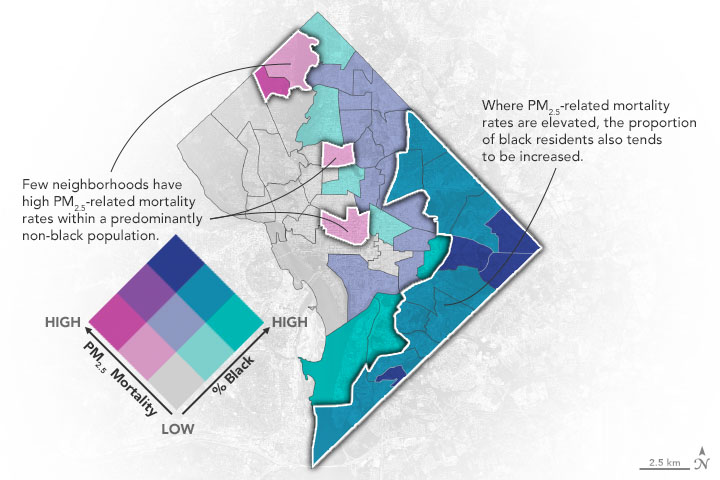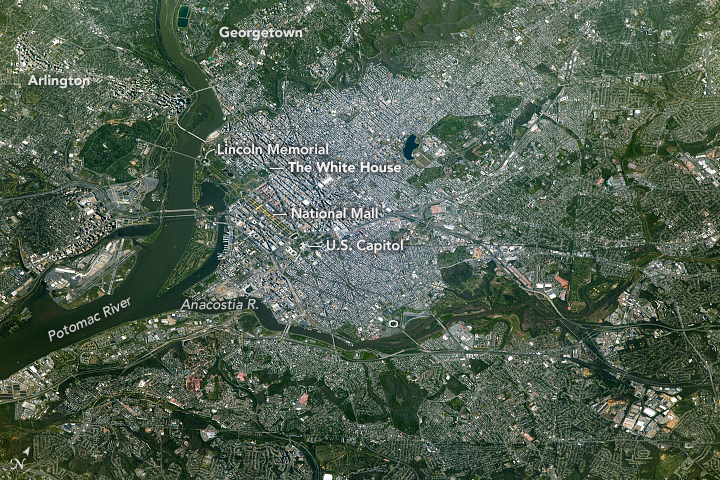An Extra Air Pollution Burden
Nov 9, 2021 / NASA – Earth Observatory / Story by NASA Earth Observatory
Like many cities in the eastern United States, Washington, D.C., has seen major improvements in air quality in recent decades. Levels of fine particle pollution (PM2.5) have declined by roughly 50 percent in the city since 2000 due to passage of a series of clean air laws.
Cleaner air has yielded significant health benefits. The number of DC residents killed by diseases related to exposure to PM2.5 (chronic obstructive pulmonary disease, ischemic heart disease, lung cancer, and stroke) declined by 50 percent during that period, according to a new NASA-funded analysis of city-wide air quality and health data.
However, the resulting health benefits have not accrued evenly, according to the researchers from George Washington University, the DC government, Boston University, Washington University in St. Louis, and Dalhousie University. By correlating hospital records with air pollution data from NASA satellites and DC Department of Energy & Environment ground-based stations, the scientists showed that populations with higher exposure to fine particulate pollution and poor air quality had higher risks of health problems.
“Exposure to PM2.5 and rates of certain health problems were highest in the southeastern, southwestern, and northeastern quadrants of the city—areas that have historically had higher percentages of people of color, as well as people with lower household incomes and lower educational attainment,” explained Maria Castillo, a research associate at George Washington University. “This adds to a growing body of evidence documenting basic inequities in who is affected by air pollution.”
Castillo and colleagues analyzed aerosol observations from several different NASA satellites, as well as ground-based air quality sensors. Ground-based monitors suggested that PM2.5 concentrations were higher in areas with lower incomes and higher proportions of Black, Latino, and other people of color, though there are only a handful of sensors located throughout the city.
“What’s great about the satellite data is that it has enough resolution that we can use it to fill in gaps where we don’t have data from monitoring stations,” explained Kelly Crawford, the director of the air quality division in the District’s Department of Energy & Environment. The satellite data indicates that concentrations of fine particulate matter were 2 micrograms per cubic meter higher in parts of the northeast, southwest, and southeast parts of the city compared to wealthier, whiter neighborhoods in the northwestern quadrant, explained Crawford.
The map above, derived from the researchers data, shows areas that generally have higher rates of PM2.5-attributable mortality. Rates of chronic obstructive pulmonary disease, lung cancer, and stroke were five times higher in DC’s southeastern quadrant compared to those from its northwestern quadrant. Rates of ischemic heart disease were nine times higher, and asthma-caused emergency room visits were 30 times higher.
Exposure to air pollution is not the sole contributor to such stark health disparities. Other factors such as access to health care, smoking rates, chronic stress, and access to quality food likely play a role. “There isn’t a one-to-one relationship between polluted air and poor health outcomes,” said Castillo. “But there is a large and growing body of evidence that makes clear that air pollution hits disadvantaged communities harder because people in these communities are more likely to breathe polluted air and because baseline health disparities make exposure to pollution especially harmful.”
The researchers say that understanding the nature of the problem is just the first step. “I hope that studies like this remind decision-makers that there are ways we can address some of these longstanding inequities. We should look carefully at where schools, senior centers, roads, and polluting industries are built to minimize exposure for vulnerable populations.”
Crawford, who was an environmental engineer at NASA’s Goddard Space Flight Center before taking a job with the DC government, draws valuable pragmatic lessons from the research. “The study underscores how essential it is that the city continue to demonstrate progress on air quality. We need to continue to move toward electrification and make sure that the vehicles on the road are running as cleanly as possible and that industries are using clean technologies.”
The satellite PM2.5 data used in the study was developed by researchers from Washington University in St. Louis and Dalhousie University. It is based on two decades of observations from NASA’s Moderate Resolution Imaging Spectroradiometer (MODIS), Multi-angle Imaging SpectroRadiometer (MISR), and Sea-viewing Wide Field-of-view Sensor (SeaWIFS). It also incorporates information from the GEOS-Chem model, a global 3-D model of atmospheric chemistry.
NASA Earth Observatory image by Joshua Stevens, using data courtesy of Castillo, M., D., et al (2021). Story by Adam Voiland.

